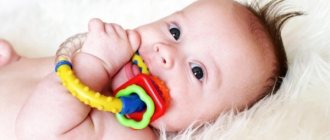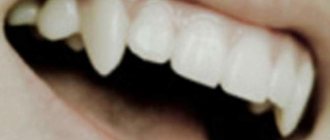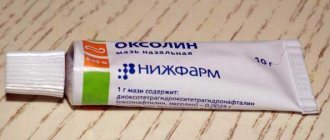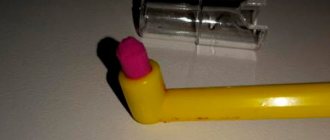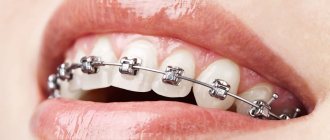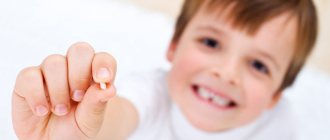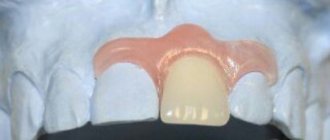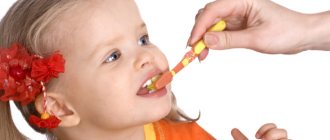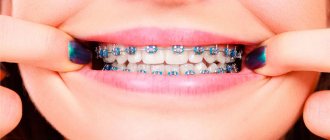Fangs protruding from the dentition - the third pair of teeth, counting from the center - is a fairly common dental pathology, occurring in approximately 30% of dental clinic clients.
The canines are located at the corners of the jaws, directly behind the incisors, and differ from them in having a longer crown and root. Canine dystopia can manifest itself in different ways:
- their protrusion from a generally even row;
- hiding behind other teeth;
- an excessively long or, conversely, short crown;
- turning around an axis.
The “vampire smile” not only affects appearance, but also seriously impairs chewing function, and therefore requires qualified orthodontic treatment.
Why do fangs erupt incorrectly?
In children, under the milk teeth in the jaw bone in the second row there are the rudiments of permanent teeth, and even deeper, in the third row, permanent fangs. Therefore, during the period of change in occlusion, the “three” canines erupt last, and the first permanent teeth become “sixes”, at the site of the eruption of which there were no milk teeth at all.
- If for any reason a child prematurely loses a milk “four” or “five,” the sixth tooth will move into the vacant space, and there will simply be no room left for the canine to erupt. He will have to crawl out either outside the row or on the palatal surface.
- The cause of pathology can also be crowding of teeth, caused by the small size of the jaw, when there is simply no room in it for the physiological placement of large complete teeth.
Anatomical structure
The anatomy of a human tooth suggests that it is conventionally divided into 3 parts: root, neck and crown. The crown is the part that rises above the gum; it is covered with enamel - the strongest tissue that protects the tooth bone from the negative effects of acids and bacteria. There are several types of crown surfaces:
- The facial is the surface on the side of the lip or cheek.
- Occlusion is the surface in the area of closure with a paired tooth, which is located on the opposite jaw.
- Contact - the surface of the crown, which faces the teeth located in the neighborhood.
- Lingual – internal part. It faces the inside of the oral cavity, that is, the surface that the tongue touches during conversation.
The neck is the part that is located between the root and the crown , connecting them, covered with cement and closed by the edges of the gums. The root is the part with which the tooth is attached to its socket. Taking into account the classification type, the root can have one or more processes.
Histology
The histological structure of all teeth is exactly the same, but all of them have a different shape, taking into account the specific function they perform.
Enamel. It is a durable fabric that consists of 95% of various salts such as zinc, magnesium, copper, strontium, fluorine and iron. And 5% consists of substances such as carbohydrates, lipids, proteins. In addition, the enamel contains a liquid that participates in physiological processes.
At the same time, the enamel also has an outer shell , which is called the cuticle; it covers the chewing surface, but over time the cuticle tends to wear off and become thinner.
The basis of the bone tissue of the tooth is dentin - a set of minerals surrounding the root canal and the entire dental cavity. Dentin tissue contains a large number of tiny channels through which metabolic processes take place and nerve impulses are also transmitted through the channels.
Root structure: pulp and periodontium
The cavity inside the tooth is formed by the pulp - this is a loose and soft tissue, penetrated through and through by nerve endings, as well as lymphatic and blood vessels.
The structure of the roots looks like this. The root is located in a special hole - the alveolus , in the bone tissue of the jaw. The root, like the crown, consists of mineral tissue - dentin, covered on the outside with cement.
The root ends with an apex , through its opening blood vessels pass that feed the dental bone. The number of roots can vary depending on the functional purpose of the teeth, from 1 root in the incisors to 5 in the chewing teeth.
Periodontium is the connective tissue that fills the gap between the jaw socket and the tooth root.
The fibers of the tissue, on the one hand, are woven into the cement of the root, and on the other, into the tissue of the jaw bone, due to this the tooth is firmly attached. In addition, through the periodontal tissue, the feeding elements of the blood vessels can enter the dental tissue.
How to normalize the position of dystopic fangs?
When choosing a technique, the orthodontist takes into account the severity and type of pathology, as well as the age of the patient. For children under 12 years of age, the use of specialized removable and non-removable structures is recommended:
- night guards worn at night;
- easy-to-maintain soft dental plates designed for long-term wear;
- trainers that target dentofacial defects.
The sooner the correction begins, the faster it will be possible to straighten teeth that are not yet fully formed. On average, the process takes 4–6 months.
Adolescents and adult patients need treatment with braces, which in severe cases will have to be worn for about two years.
Outdated views
Until quite recently, scientists were unanimous in the opinion that a person needs fangs, first of all, to tear meat. This is how predators use these teeth.
Indeed, fangs make it possible to more effectively attack and hold the victim, and later tear off pieces of meat from the carcass. Other animals, for example, the hippopotamus, thanks to long teeth of this type, manage to drive away even the most dangerous predators. Today, none of these possible functions of fangs is relevant for humans. Scientists were able to determine the real purpose of teeth of this type.
Features of canine correction with braces
The problem can be solved with or without tooth extraction. Both methods help to obtain the space that is missing, but necessary for the dystopic canine to be returned to its place. The choice of the optimal option depends on the clinical situation.
- If removal is not performed, free space is formed due to the gradual lengthening of the dentition with braces. The doctor must assess in advance how the process will affect the proportions of the face.
- If changes in appearance turn out to be negative (for example, the front teeth deviate noticeably forward), a pair of teeth will have to be removed - usually the first premolars.
There is no need to be afraid of removing completely healthy teeth. This method will be suggested by the doctor only if absolutely necessary - to improve chewing function, balance load distribution and maintain the health of the remaining teeth. Due to the free distribution of tooth roots, in this case a stable correction result that is not prone to relapse will be achieved.
Orthodontic patients often ask: is it possible to put braces on one jaw? Dystopic fangs are just that case. If there is a need for significant straightening of the canines with braces on the upper jaw and minor correction of the lower dentition, the lower bracket can be installed later, which is more financially beneficial for most patients.
How to determine a person's character by the shape of their teeth
For example, African Americans and Southern Chinese are much more likely to have premolars with two canals rather than one. In addition, among the Asian group, wide and long incisors are more common, and among the Slavs, the first incisors protrude lower than the second, in contrast to the same American standards of the Hollywood smile, where an absolutely even semicircle of the cutting edge of the upper teeth is adopted. However, even based on such purely national traits, people try to interpret the character traits of their interlocutor.
Incisors
A stubborn and decisive, intuitive and open person has outstanding incisors - physiognomy tells us. Risk-taking and explosive character should be suspected in those with diastema. The gap between the incisors also indicates a person’s willingness to make quick decisions, but an unwillingness to think through their consequences. The soul of the company, judging by the provisions of this “science”, is certainly with long incisors. However, he can make fun of his comrades, often quite viciously.
Photo: GLOBAL LOOK press/Chris Robbins
Fangs
Long and large fangs signal the aggressiveness of their owner. However, this association has more in common with nature than some other provisions. In addition, prominent fangs are considered a sign of a person’s love of love and his perseverance in achieving his goals. In Japan, large fangs, moreover, located outside the dentition, hint at adolescence, when the orthodontist has not yet taken up the matter. It is these associations that force Japanese women to specifically increase these teeth in order to have more success with men.
Smooth or curved
Prudence, responsibility, self-confidence and even wisdom are attributed to people with perfectly straight teeth. They are generally expected to be mathematically precise and goal-oriented.
Crooked teeth, on the contrary, reveal a person who is hot-tempered, stubborn, and also unsociable, who does not allow the possibility of mistakes both in relation to others and to himself. Even an impossible task, in which such a person believes, he will solve with persistence worthy of better use. On the other hand, those with crooked teeth are credited with excellent intuition and the ability to see a situation from all possible sides.
Small or large
Introverts, according to physiognomists, should get small teeth, and the darlings of fate should get large, dense teeth. And if the incisors are also longer than their neighbors, then wealth, fame and success will literally follow on their heels.
Photo: GLOBAL LOOK press/Andrey Arkusha
Jaws and character
Even a person’s ability to develop his own personality is reflected in the condition of his teeth. So, for example, it is believed that the upper teeth on the left demonstrate how well a person knows himself and knows how to use his abilities for his own benefit, and on the right they show how easy it is for a person to find his place and “take it.” The lower teeth on the left show the family relationships of their owner, and on the right they reflect his ability to analytically assess reality. Accordingly, dental diseases of the corresponding side indicate problems in one or another area of life.
Body health and dental damage
Increasingly, scientists are talking about the integrity of the entire organism and its indivisibility into individual organs. That is why damage to various parts of the human body immediately affects the condition of his teeth. Thus, liver diseases affect the condition of the fangs, especially the lower jaw. The pancreas, lungs and small intestine give distress signals through the premolars, and joint disease is manifested by the destruction of the incisors.
In addition, the incisors are “responsible” for the kidneys, bladder, and the heart and small intestine are closely connected with wisdom teeth. Such maps of organ correspondence are studied by medical specialists, so if you cannot boast of healthy teeth, we recommend that you undergo a full examination of the body and identify the root of the problem. However, no one has canceled tooth decay due to poor hygiene or ignoring preventive appointments at the dentist.
The modern scientific community does not recognize the existence of such a science as physiognomy, and yet it is sometimes interesting to notice how popular rumors regarding large or small teeth correspond to reality. Still, it should be recalled that modern dentistry can correct almost any dental situation, and careful hygiene and preventive examinations every six months will preserve a beautiful smile for many years.
Author: head of the online magazine about dentistry Startsmile.ru Yulia Klouda.
READ "DAYS.RU" IN "ZEN" - ONLY IMPORTANT NEWS
Symptoms of canine eruption
The photos below show quite clearly how the eruption of fangs occurs in children. The main signs of this process are a runny nose and excessive tears, which can even cause conjunctivitis in children. Often, when children cut their fangs, the symptoms are complicated by an increase in temperature, which can reach 38 degrees. The child’s gums swell and turn red, saliva flows profusely, and because the gums hurt and itch, the child puts everything he can reach into his mouth. Some children may experience pain in the nose or ears. Often, when fangs erupt, symptoms may be accompanied by digestive disorders, diarrhea and a significant decrease in appetite.
A child’s fangs are cutting and his gums are itching - how can you help your baby during this difficult period?
The child’s body is weakened at this time, so his immunity weakens, which means that he can develop any viral infection. It is very important to monitor very carefully how the child feels in order to have time to notice any deviations in his health.
To significantly simplify the difficult task facing your baby and ease his suffering, you can buy a special silicone toy, which is pre-cooled in the refrigerator and then given to the baby to chew on. You can let your baby chew on a terry towel, a piece of dry bread or a cool banana. You can also massage the baby’s gums, and if it is very painful, then additionally use children’s pain-relieving gels and chamomile oil for this.
If the child does not have allergies, bee honey can be used for massage. It is important to remember that any drugs that contain alcohol cannot be used for massage, just as you should not give aspirin and analgin to the baby. If a child is cutting his fangs, the symptoms can be any, but to reduce the temperature, only syrups or suppositories with paracetamol are allowed, and even in this case, you should first consult a pediatrician.
All local pediatricians advise that as soon as the first symptoms of teeth eruption appear in a child, very closely monitor his health. Fever and diarrhea, as well as a runny nose and cough, may indicate an infection, so you need to contact your pediatrician for a full examination, and if a disease is detected, begin treatment immediately. In case of infection, it is very important to contact the pediatrician in time and prescribe the correct additional treatment for the baby.
Teether toy to relieve itchy gums during teething
In addition, it should be remembered that any upset of the digestive system, even if it is actually caused by teething, can lead to dehydration of the child's body, which is very dangerous for babies, which means that the child needs to drink more at this time.
Read also: Treatment of malocclusion in children
To make it easier for the baby to endure the troubles caused by teething, it is recommended to carry him in your arms more often, distract him from painful sensations with games, as well as caress and hug him. Many babies tolerate teething calmly and cut their teeth less painfully. For those who have never encountered these problems and do not know how teeth cut in children, the photos on this page will clearly demonstrate the condition of the child’s gums during the teething period.
What symptoms appear when a child has fangs?
The most striking symptom of teething in a child is excessive salivation, but such a manifestation does not occur immediately. 3-4 weeks before the moment when the tooth should erupt from the gums, preparation of its roots begins. The process is invisible externally, but the baby already feels discomfort, so the initial signs of early teething are manifested by changes in behavior:
- there is no mood, causeless whims appear;
- sleep becomes restless, its rhythms are disturbed;
- there is a need to put things in the mouth and chew on toys.
External symptoms of canine teething will appear when a small white spot forms on the lower gum - this is a baby tooth ready to erupt to the surface.
External signs
2-3 days after the baby’s mood deteriorates, parents may notice the first visible signs of teething:
- in places where teeth grow, swelling and redness are observed, the gums become prominent, as in the photo;
- pain increases in the area of the gum where the new tooth will emerge;
- salivation increases;
- the temperature rises to low-grade levels – 37–37.3 °C;
- The child’s appetite noticeably worsens, sometimes he completely refuses food.
The most difficult time for parents is when the child’s fangs erupt with an increase in unpleasant and painful symptoms:
- drooling causes irritation around the mouth and a rash on the chin;
- loose stools are possible, which, according to pediatricians, is the result of swallowing a large volume of saliva;
- salivation can provoke vomiting;
- when the fangs climb to the surface, the child’s body temperature can reach critical values – up to 38–38.5 °C;
- Increasing itching covers nearby tissues.
A child who is teething constantly chews on toys in order to somehow suppress the itching and painful sensations in the gums.
Temperature
If body temperature does not exceed normal limits, such hyperthermia is considered a normal physiological manifestation of the body’s internal defenses. When a child loses his lower or upper fangs, his gums become inflamed, so the body mobilizes internal reserves to fight inflammation, which is accompanied by an increase in temperature.
What parents should consider:
- How many degrees can the thermometer increase? According to pediatricians, values exceeding 39 °C are critical for a child.
- How long can the temperature last? It is unacceptable for a high temperature to last longer than 3-4 days. A slightly elevated temperature usually subsides after 5–7 days.
If hyperthermia continues for a long time, or the thermometer rises too high, you need to seek medical help. The child’s body, weakened due to teething, is susceptible to viruses and infections, so the baby could become seriously ill.
Is it true that teething is the most painful part?
The appearance of fangs is indeed the most difficult and uncomfortable process for children, which is associated with the anatomical features and location of these teeth. Their roots are quite long and go deep into the gums. In addition, the upper canines are located close to the facial nerves, which is why they are called “eye” teeth. When cutting through this pair of teeth, in addition to the usual characteristic symptoms, the child may experience lacrimation and other signs of conjunctivitis.
The eruption of fangs on the lower jaw is not so painful, so such teeth bother babies less, however, parents should be prepared for an increase in temperature for up to 3 days, and short-term upset bowel movements, and other “dental” symptoms that worsen the well-being and mood of the little one .
If your front tooth hurts after treatment
Patients often complain that their front teeth hurt after treatment. The dentist cleaned the canals, so this is normal. The discomfort should go away within a few hours. But if the treatment is done poorly, the tooth may hurt for a long time - and this is already a deviation from the norm. Most likely, the doctor made a mistake during treatment and the entire filling process will have to be repeated. The cause of pain can be a burn of the pulp, damage to the enamel, an allergy to medications, or acid contact with dentin.
How to help your baby during teething
Many of the symptoms that occur when children are teething can be relieved. Home and medical methods will come to the rescue:
- Gel teething toys, as in the photo, will relieve itching of the gums, but the baby should not chew on them without a break - such items are periodically washed, cooled in the refrigerator and given to the child again.
- Pharmacy anti-inflammatory and analgesic gels for local applications will help relieve inflammation and pain. Dentinox, Kalgel, Baby Doctor, Kamistad are used in pediatric dentistry.
- If a child’s fangs are cutting due to a high fever, antipyretic medications can be used. Paracetamol-based drugs effectively relieve fever and inflammation. Drugs containing ibuprofen are no less well tolerated by infants.
Children's antipyretics are available in several dosage forms. For children of the first year of life, syrups or suppositories are relevant. Potions quickly reduce the temperature, but their effect is short-lived. Candles do not work immediately, but they last a long time. Before using any product, consult a doctor.
How to help your baby?
Since cutting fangs cause discomfort in many children, the task of parents should be to support their children during such a difficult period and surround them with care. To make it easier for children to overcome the process of the appearance of fangs, you can:
- Invite your child to chew toys specially designed for this purpose , called teethers. Inside they are filled with gel or water. By placing this toy in the refrigerator for a while, mom will help cool her gums and eliminate itching. You can also let your baby chew nipples on a bottle and special orthodontic pacifiers.
- Use pharmaceutical medications in the form of gels that have an anesthetic and anti-inflammatory effect. These include Dentinox, Kamistad, Dantinorm Baby, Kalgel, Baby Doctor First Teeth and other similar products. It is only important to remember that before using any of the gels listed in children, you should consult a pediatrician.
- If the temperature rises above +38°C and after consultation with a pediatrician, the child is given an antipyretic drug. The drugs of choice in childhood are medications containing paracetamol. An alternative option is drugs that contain ibuprofen. Both medications are safe even in infancy and are effective in relieving fever. Moreover, they are presented in several forms, among which candles and syrups are most relevant for children in the first years of life. The effect of syrup is faster, but also shorter, and candles, although they do not reduce the temperature immediately, have an effect for a longer period.
Growing pains
At 9-12 years of age, the growth of eye teeth can cause temporary inconvenience and discomfort. And at the age of one and a half years, as the first baby fang moves apart the gum in its desire to grow outward into the oral cavity, this can cause serious suffering to the child. Crying at night, whims - this is a short list of what the parents of a baby have to endure, with whom some kind of meaningful dialogue has just begun to develop, who seems to have already learned to react “correctly”, from an adult point of view, to the environment - and here The relationship between an owl slides down to the level of a baby.
Moreover, disoriented by the confusion of day and night into which their child has been driven, parents may mistake the symptoms of eye teeth growing into something else. In eye disease, as often happens. Therefore, contacting a pediatrician should take place as early as possible.
In complicated cases, the child will be prescribed medications that significantly reduce swelling of the gums and relieve pain. These, after a medical examination and prescriptions, can be pain-relieving gels “Metrogil Denta”, “Kalgel”, “Kamistad”.
In adolescence, it is time to replace a baby tooth with a permanent one. It often happens that a well-fitting baby tooth does not want to leave its place and prevents the “adult” tooth from taking its place between the incisors and premolars. In such a situation, the canine may grow incorrectly, with a displacement inward, towards the tongue, or outward, towards the cheek, which will distort the bite and will not contribute to normal chewing of food.
Treatment of caries of anterior teeth
The main method of treating caries in the front teeth is filling. When it comes to incisors, in the language of dentists this is called very beautifully - artistic restoration. It is better not to save on the cost of the filling. High-quality material will last longer and will not spoil your smile. The front teeth are always visible, so the dentist has to select the color and degree of transparency of the filling with pinpoint precision; it must match the shade of the tooth as closely as possible. Reflective composite materials do not spoil the aesthetic appearance. Over time, light fillings do not darken or wear off.
How much does front tooth treatment cost?
The cost of treatment depends on the method and materials used. When it comes to the smile area, it is better not to skimp. In this case, prudent patients often have to remember the stingy man who pays twice. Choosing cheap materials often leads to aesthetic flaws, disappointment and repeated treatments.
As a rule, prices for treatment of front teeth in Moscow start from 2,000 rubles. For example, the cost of caries treatment without drilling ranges from 2,000 to 5,500 rubles. A light seal costs from 1,500 to 10,000 rubles. The price tag for splinting loose front teeth starts from 2,800 to 7,000 rubles. Removing a cyst will cost 7,000 - 37,000 rubles, granulomas - from 5,000 to 40,000. A dental inlay will cost from 5,200 to 20,000 rubles. Prices for veneers start from 5,000 rubles, lumineers - from 40,000. The range of prices for zirconium crowns is from 13,500 to 40,000, ceramic - from 17,000 to 57,000. Clasp prosthesis will cost from 29,000 to 73,000, dental implantation - from 30,000 to 120,000 and more.
Loose front teeth
Loose front teeth are a wake-up call. Often this trouble happens with the front teeth. The main cause of looseness is gum disease: periodontal disease, stomatitis, gingivitis. You should not run them, otherwise you may end up without teeth at all.
The doctor will select the treatment for loose teeth individually. If the swaying is accompanied by pain, the teeth deviate significantly to the sides, the dentist applies special splints, removable or non-removable, to the incisors. Splinting strengthens mobile teeth, prevents their loss, and allows periodontal tissues to recover. In severe cases, surgical treatment cannot be avoided. During surgery, the surgeon removes bone tissue or restores it using metal shunts.
Cysts in the tooth canal and granuloma have a bad effect on the roots, and the teeth begin to become loose. These tumors need to be removed. If the tooth begins to loosen after a blow or injury, it is better to go for an x-ray.
Normal and deviations in tooth sizes
All dental units of the same name have approximately the same height and width, except for the central (medial) incisors. The size of the front teeth of the upper jaw is normally slightly larger than that of the lower jaw. The height of the crown of the upper central incisors varies from 9 to 12 millimeters, width - from 8 to 9 millimeters. The lower teeth are similar in height, but are about 5 millimeters wide. The size of a person's wisdom teeth does not differ from the parameters of other molars. The table below shows the average width of dental crowns in millimeters.
| Upper jaw | Lower jaw | |
| Medial incisor | 8.5 mm | 5.3 mm |
| Lateral incisor | 6.5 mm | 6 mm |
| Fang | 7.6 mm | 6.7 mm |
| First premolar | 6.7 mm | 6.8 mm |
| Second premolar | 6.4 mm | 7 mm |
| First molar | 9.4 mm | 10 mm |
| Second molar | 9.4 mm | 10.2 mm |
Anomalies in the size of human teeth can be congenital or acquired and are accompanied by malocclusion, impaired chewing functions and an unaesthetic appearance of a smile. The most common deviations are macrodentia and microdentia.
How to prevent dental problems
Any mother wants her child’s teeth to be strong and durable, but caring for them should begin long before the permanent teeth erupt. More precisely, you need to start caring for children’s teeth during pregnancy, when they are formed in the fetus. The more attentive a mother is to her lifestyle and diet, the fewer dental problems the child will have both in the first years of life, when baby teeth appear, and in adulthood.
A pregnant woman should eat enough dairy products, fish and seafood, and also take mineral complexes containing calcium on the advice of a gynecologist. The baby needs this macronutrient for the formation of tooth buds, and if there is a deficiency in the expectant mother’s diet, this can cause dental problems in the baby.
After childbirth, children require adequate nutrition for normal dental development, and breast milk is considered the best option. At the same time, a nursing mother must eat a balanced diet. If it is impossible to breastfeed, the baby is given a high-quality formula containing all the elements for teeth growth.
To ensure the health of both primary and permanent canines is strong, you should not introduce your child to sweets too early. It's best to save candy and chocolate until your 3rd birthday or later. In addition, it is worth limiting the consumption of juices, because they have a fairly high sugar content. It is especially dangerous for the strength of the fangs to give sweet drinks before bedtime.
Daily hygiene is also important to maintain the health of the canines. While the teeth are still cutting, you can clean them with a silicone fingertip or a gauze swab, and for an older toddler, purchase an age-appropriate brush and toothpaste.
You will learn a lot of other useful information by watching Dr. Komarovsky’s program.
